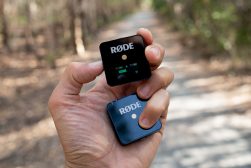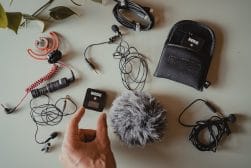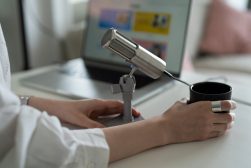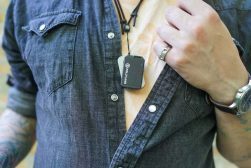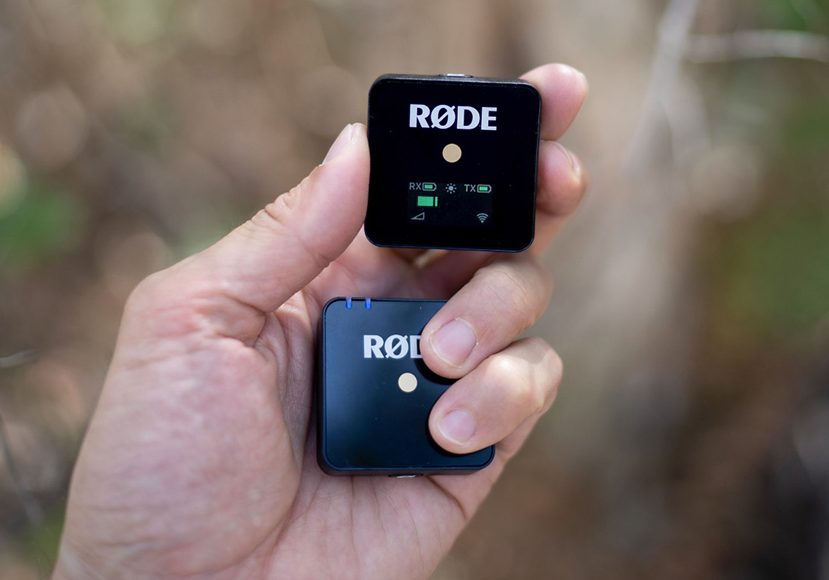
Best Lavalier Mic in 2024 (for iPhone, YouTube, Podcasts, etc)
Getting great audio from a lavalier mic is easy and convenient if you know what you're doing. Discover the best products and some pro tips for great results.
Shotkit may earn a commission on affiliate links. Learn more.
The best Lavalier microphones are an unobtrusive way to record audio and speech.
A good lapel mic is discreet enough to be almost invisible and provides a direct line input to a sound recorder or wireless transmitter.
I like to fasten a lavalier mic to a groom’s jacket at a wedding before his speech, with the mic running into my iPhone, which is placed in the groom’s rear trouser pocket.
This provides a foolproof way to record audio with excellent sound quality, even when I just use the default iOS sound recording app.
Whatever reason you need a lavalier microphone, this guide will help you choose the best one for your needs.
You should also check out our article on the best wireless microphones for some more options.
What are the Best Lavalier Microphones in 2024?
Rode Wireless GO II (Best Lavalier Microphone Overall)
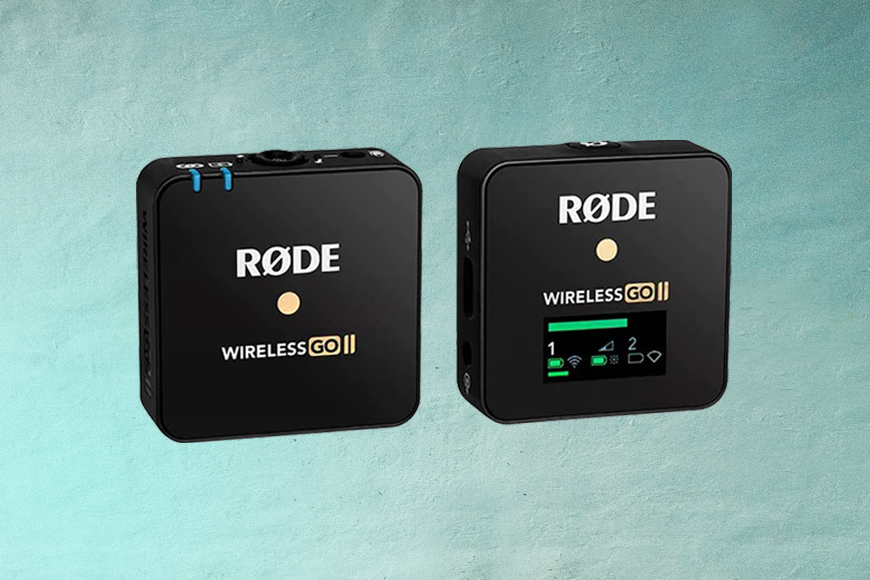
- Exceptional sound quality
- Versatile dual-channel capability
- In-built rechargeable battery
- Impressive range of 200m
- Gain adjustment lacks precision
- Limited onboard settings, some require computer access
The Rode Wireless GO II, our pick for the best overall lavalier microphone of the year, is an evolution of an already fantastic device.
Having used the first model extensively (see video below), I was impressed by the enhancements made in the second iteration.
This new version has an omnidirectional polar pattern, making it perfect for picking up sound from all angles.
With its broad frequency range of 50Hz to 20kHz, it faithfully captures both low and high-pitched sounds.
Noteworthy is its high maximum SPL of 100 dB SPL (at 1kHz @ 1m), which allows it to accommodate loud sounds without distortion, while the maximum input level of -20dBV ensures balance between soft and loud sounds.
The Wireless GO II is powered by a built-in rechargeable lithium-ion battery, offering up to 7 hours of operation, a significant improvement from its predecessor.
What’s also impressive about this device is its compactness. Both the transmitter (TX) and receiver (RX) weigh around 30g and 32g respectively, and their dimensions are strikingly petite, making them perfect for on-the-go recording.
Above all, the transmission range of 200m (line-of-sight) sets the Rode Wireless GO II apart, enabling flexibility during recordings.
In comparison to the first model I owned, the Rode Wireless GO II showcases vast improvements, solidifying its spot as one of the top lavalier microphones for any recording need.
DJI Mic (Best Lavalier Microphone for Vlogging and Interviews)
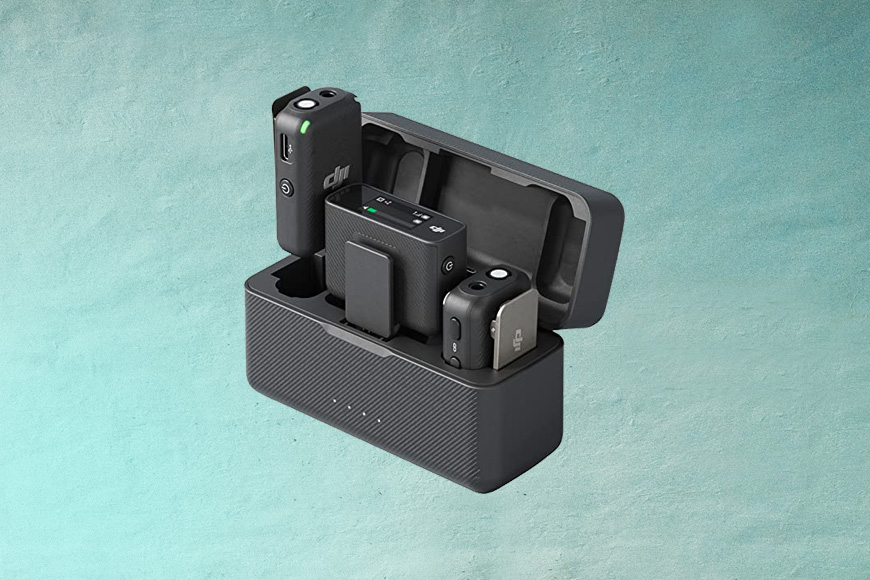
- Wireless, compact design
- Reliable operating time of 5.5 hours
- Resilient to temperature variations
- Impressive 250m transmission distance
- Buttons prone to inadvertent activation
- Only supports mono recording on iPhone
- Lacks a low-latency monitoring mode
The DJI Mic has been specially designed as an ideal companion for vloggers and interviewers, and its impressive specifications are a testament to that.
Starting with its compact size, measuring at just 47.32×30.43×20.01 mm, and weighing a mere 30g, it’s the epitome of portability.
The operating frequency ranges from 2400-2483.5 MHz, powered by a GFSK 1 Mbps and 2 Mbps wireless mode.
This contributes to its solid connection stability and remarkable audio clarity, ensuring your content is always top-notch.
The battery life is impressive too, with a 320 mAh capacity that provides 5.5 hours of operating time, and it only takes 70 minutes to fully charge.
The battery itself is a durable LiPo 1S type, which is known for longevity and reliability.
The DJI Mic is quite a hardy piece of equipment, able to operate in temperatures ranging from -10° to 45° C, which means you can count on it in a variety of environments.
One unique feature is its all-direction microphone directions, with a frequency response from 50 Hz – 20 kHz when low cut off, and 150 Hz – 20 kHz when low cut on.
This ensures that no matter how you’re recording, the DJI Mic captures clear, high-quality audio.
For vloggers or interviewers on the move, you’ll appreciate its maximum transmission distance of up to 250m (FCC) and 160m (CE) in an unobstructed outdoor environment, allowing you flexibility in your setup.
Whether you’re on the bustling streets of a city or the quiet corner of a cafe, the DJI Mic is equipped to deliver outstanding performance.
It’s a solid, trustworthy ally for all your vlogging and interviewing needs.
Shure MVL (Best Lavalier Microphone for iPhone and Tablets)
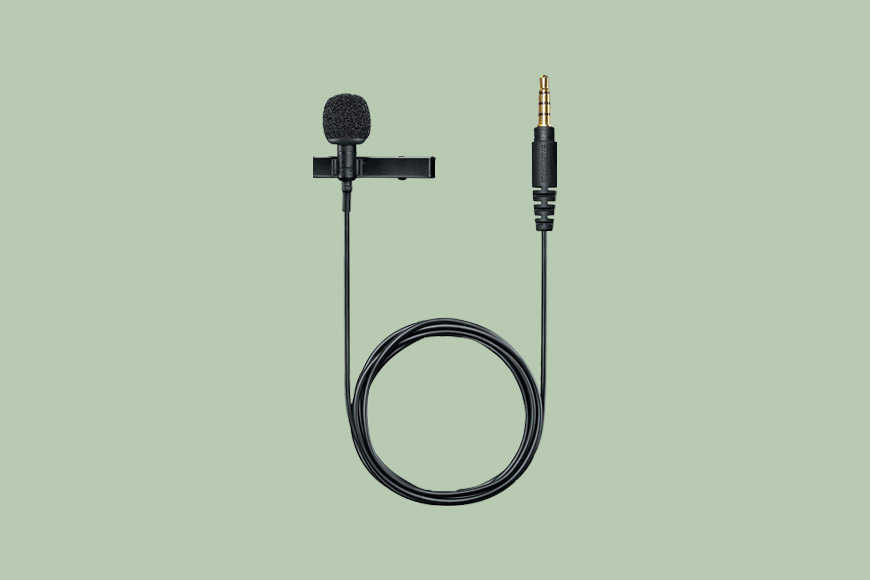
- Apple MFi certified for seamless compatibility with iOS devices
- Midrange sound appreciated by users
- Compact and lightweight design
- Easy to use with the ShurePlus MOTIV app
- Requires Robe Central app for full functionality on iPhones
- Limited frequency response range
- May require additional adapters for certain devices
This may be the best Lavalier mic for iPhones.
The Shure MVL, our top lapel mic for iPhones and tablets, stands out with its exceptional specifications and features tailored specifically for iOS users.
Being an Apple MFi certified microphone, it is designed to work seamlessly with all iOS devices that have a Lightning connector.
As an iPhone user myself, I appreciate the simplicity and compatibility of this device.
Its sound quality among lav mics for iPhone is subject to personal preference, but users who lean towards the Shure MVL often applaud its strong performance in the midrange frequencies.
It stands neck and neck with the Rode SmartLav+, offering another excellent option for your iOS devices.
To make the most out of the Shure MVL, it’s recommended to pair it with the ShurePlus MOTIV app.
This companion app opens up a world of customization, ensuring you get the best audio for your recordings.
The Shure MVL boasts an omnidirectional polar pattern with a frequency response of 40 Hz to 20,000 Hz, ensuring a broad spectrum of sound is captured.
The microphone can handle a maximum SPL of 124 dB, showcasing its capacity to capture loud sounds without distortion.
Its sensitivity sits at -44.0 dBV at 1 kHz (Pa=94 dB SPL), offering a high level of clarity and balance in your audio.
One feature I appreciate is its low equivalent output noise of just 29 dB A-weighted, keeping those pesky background noises at bay.
The housing is cast zinc, making it durable for long-term use, and with dimensions of 15.2mm x 5.5mm x 132cm (H x W x D), it’s compact and lightweight, perfect for on-the-go usage.
Whether you’re interviewing, podcasting, or capturing a wedding speech on your iPhone or iPad, the Shure MVL is a solid, reliable lapel mic that delivers excellent audio quality, flexibility, and ease of use.
Rode SmartLav+ (Best Lavalier Microphone for Podcasting and Youtube Videos)
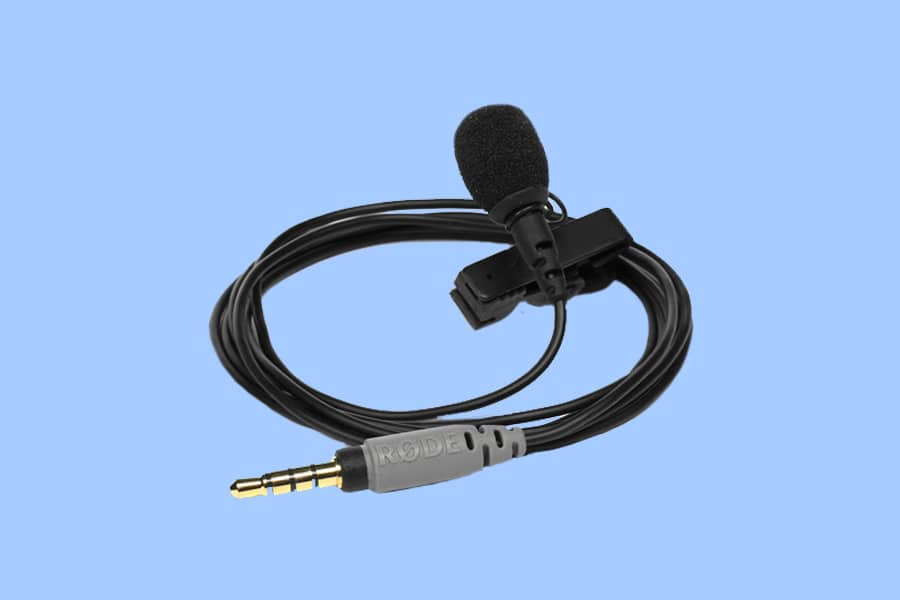
- Compact and discreet design
- Excellent sound quality for podcasting and YouTube videos
- Easy to use with the Rode Rec app
- 12-month warranty provides peace of mind
- May pick up clothing rustle or handling noise
- Requires additional equipment for wireless use
If you want to explore YouTube or podcasting, this is the best wireless lavalier microphone for you.
The Rode SmartLav+, our favourite lapel mic for podcasting and YouTube videos, is packed with features that make it an excellent choice for content creators.
Firstly, the SmartLav+ is an incredibly compact and lightweight microphone.
It’s an excellent solution for interviews or any situation where you need the microphone to go unnoticed while still capturing crystal-clear audio.
The fact that it is a permanently polarised condenser microphone with an omni-directional polar pattern ensures that it will pick up sound evenly from all directions.
The microphone boasts an impressive frequency range of 20Hz – 20kHz, ensuring that it will faithfully capture both low and high-pitched sounds.
The signal-to-noise ratio of 67 dB and equivalent noise of 27 dB is quite good, meaning your recordings will have minimal background noise.
One thing I love about the Rode SmartLav+ is its maximum SPL of 110 dB. This makes it capable of handling louder sounds without distorting the audio, perfect for dynamic podcasting and YouTube recording scenarios.
This nifty microphone operates using the power from the iPhone TRRS socket (2.7V), eliminating the need for extra batteries.
You’ll find the best results when using this mic in conjunction with the Rode Rec app. The app offers advanced features and helps ensure you get the most out of your SmartLav+.
The Rode SmartLav+ comes with a 12-month warranty. That’s a solid peace-of-mind factor when investing in a new lapel mic.
Sennheiser MKE 2-EW (Best Lavalier Microphone for Professionals)
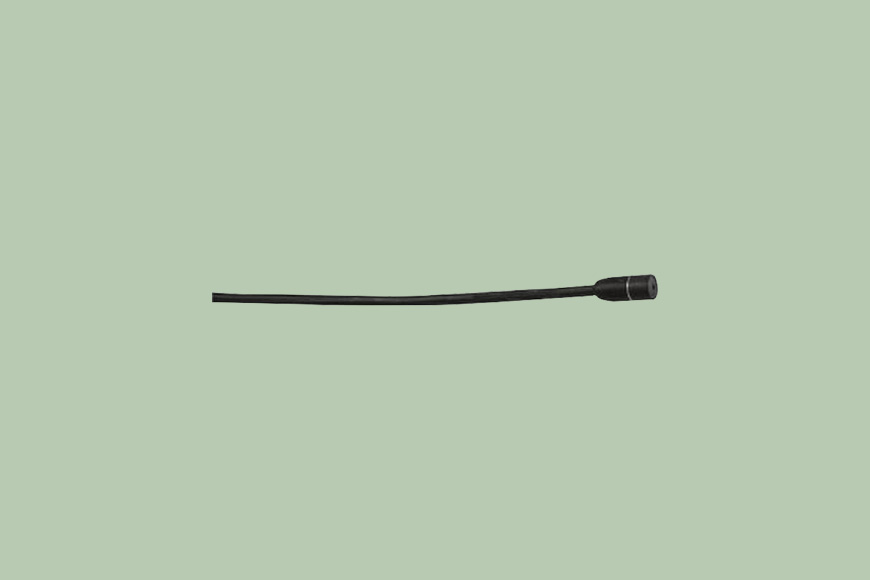
- High-quality construction and durability
- Excellent sound quality for speech and instrument applications
- Special umbrella-diaphragm protects against moisture and sweat
- Well-suited for theater productions
- Higher price point compared to some alternatives
- Requires phantom power from EW series transmitters
The Sennheiser MKE 2-EW, our top recommendation for professionals, truly shines in live situations, both for speech and instrument applications. Hands down one of the best best lapel mics on the market today.
Its high-quality design, exceptional sound quality, and robustness against moisture and sweat make it a reliable choice for professional use in varied scenarios.
This fantastic little microphone features an omnidirectional polar pattern, ensuring that sound is captured accurately from all directions.
With a frequency response of 100 Hz – 20 kHz, the MKE 2-EW does a great job of reproducing a wide range of frequencies, from the deepest bass to the highest treble notes.
One standout feature is its maximum input sound level of 133 dB (THD = 1%), meaning this mic can handle loud sources without the risk of distortion.
The condenser transducer also ensures that your audio will be clear and detailed.
The MKE 2-EW is powered by phantom power provided by EW series transmitters, making it an easy and convenient option for those already invested in the Sennheiser ecosystem.
Perhaps the most notable feature of this microphone is the special umbrella-diaphragm that protects it against moisture and sweat.
This feature alone makes it an ideal choice for theatre productions and other live performances where durability is paramount.
Despite being packed with professional-grade features, the Sennheiser MKE 2-EW is surprisingly lightweight at just 1g, and its dimensions of 12 x 6mm make it unobtrusive in any setting.
All these features come together to make the MKE 2-EW one of the best lavalier microphones on the market, offering a reasonable price point for such outstanding performance.
Countryman B6 (Most Versatile)

- Smallest and most versatile lavalier microphone
- Provides high-quality sound
- Omni-directional pickup pattern
- Low handling noise
- May require additional accessories for certain devices
- Smaller size may make it more challenging to handle or position
- May not offer the same level of sound richness as larger microphones
When it comes to versatility in the world of lavalier microphones, the Countryman B6 absolutely shines.
The smallest and most adaptable lavalier microphone I’ve come across, it’s a tool that can adapt to just about any audio scenario you can throw at it.
This diminutive powerhouse supports a mono sound field and comes with an impressively wide frequency range of 20 Hz to 20 kHz.
This ensures that it’s able to faithfully capture a full spectrum of sound, from the lowest bass notes to the crispest, clearest highs.
Despite its petite size, the B6 can handle a Maximum SPL of up to 120 dB, meaning it can cope with relatively loud sounds without suffering from distortion.
This makes it an ideal pick for environments where sound levels can fluctuate.
With a sensitivity of 16.0 mV/Pa, the Countryman B6 is capable of picking up quiet sounds effectively. This level of sensitivity ensures you get excellent audio capture, regardless of your recording conditions.
The B6 weighs an incredibly light 0.07 oz (2 g). This makes it easy to clip onto clothing or other materials without causing discomfort, and it’s so small, it’s almost invisible to the eye.
Zooblu Wireless Lavalier (Best iPhone Budget Lav)
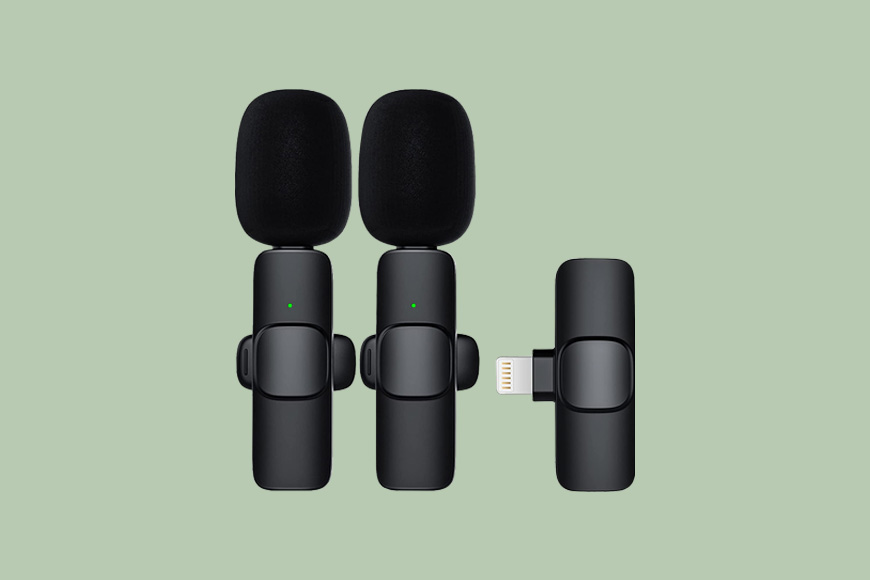
- Easy and automatic connection without the need for additional apps or Bluetooth
- Versatile compatibility with various devices
- Professional full band audio quality with Real-Time Auto-Sync Technology
- Rechargeable transmitter and receiver for extended use
- Longer charging time required
- May not be suitable for very cold environments
For those on a budget but still in search of high-quality audio for their iPhone or iPad, the Zooblu Wireless Lavalier is a real winner.
This highly-rated lavalier mic offers full band audio with 44.1~48kHz stereo CD quality and features Real-Time Auto-Sync Technology, all at a fantastic price point.
No need for extra apps or adapters with this one, just plug the receiver into your device, turn on the mic and boom, you’re good to go.
It provides a solid, automatic connection and sync, hassle-free.
What really sets the Zooblu apart is its multi-directional sound reception.
Offering professional full band audio and supporting Multi-Channel Real-Time Mixing, it beautifully balances background music and vocal audio in real time.
And here’s a great bonus, it has a built-in 65MAH rechargeable battery that provides more than 6 hours of continuous use. Plus, it has an impressive barrier-free connection range of more than 20m.
In summary, the Zooblu Wireless Lavalier Mic offers excellent value, making it our top choice for the best budget lavalier microphone for iPhone and iPad users.
PowerDeWise (Best Lavalier Microphone for Video Conferencing)
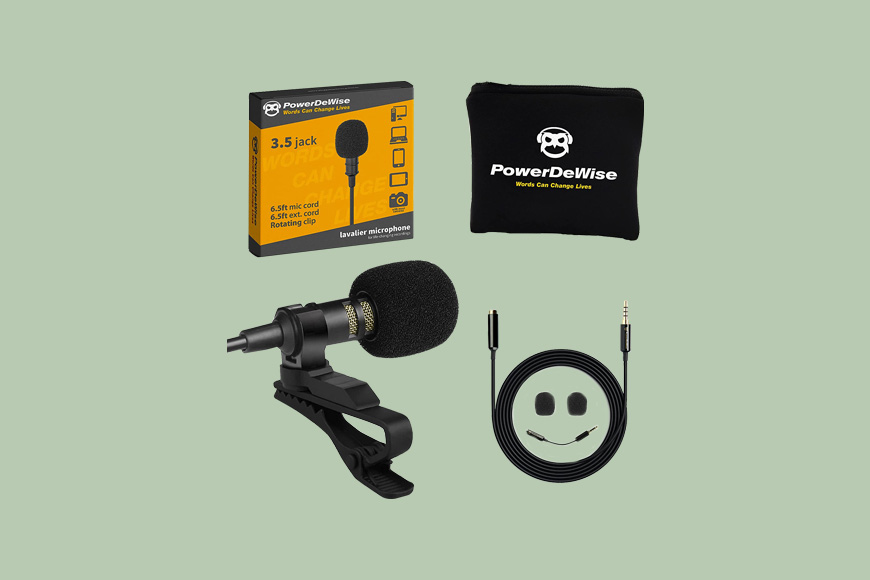
- Equipped with advanced noise cancellation technology for clear sound
- Versatile compatibility with smartphones, DSLRs, camcorders, and more
- No battery or charging required, always ready to use
- Comes with a lavalier microphone and USB Type-C sound card
- Rquires a separate app for adjustments on iPhones
- Some users may prefer more advanced features or settings
- Limited to mono audio recording with iPhones
If you’re someone who’s on video conferences all day long, then the PowerDeWise Lavalier Mic is a stellar choice for you. This lav mic boasts advanced noise cancellation technology that effectively filters out any background noise and distractions, allowing your voice to come through with a warm, natural tone.
One big plus here is that it’s 100% wired. So there’s no need to worry about radio interference, battery life, or charging. It’s always ready to use. Just plug it in, and you’re all set to start your video conference.
Another cool feature is the USB Type-C sound card. No drivers needed!
It’s compatible with Android, Cameras, Camcorders, Audio Recorders, Tablets, Laptops and even iPhone (though you might need an adapter).
It comes with a 79″ (2m) cord and an additional 2m extension cord in the box. Plus, it includes a handy case for easy storage and transportation.
With its excellent sound quality, universal compatibility, and one-year warranty, the PowerDeWise Lavalier Mic is our top budget pick for video conferencing needs.
BOYA by M1 (Best Ultra-Budget Lavalier Mic)
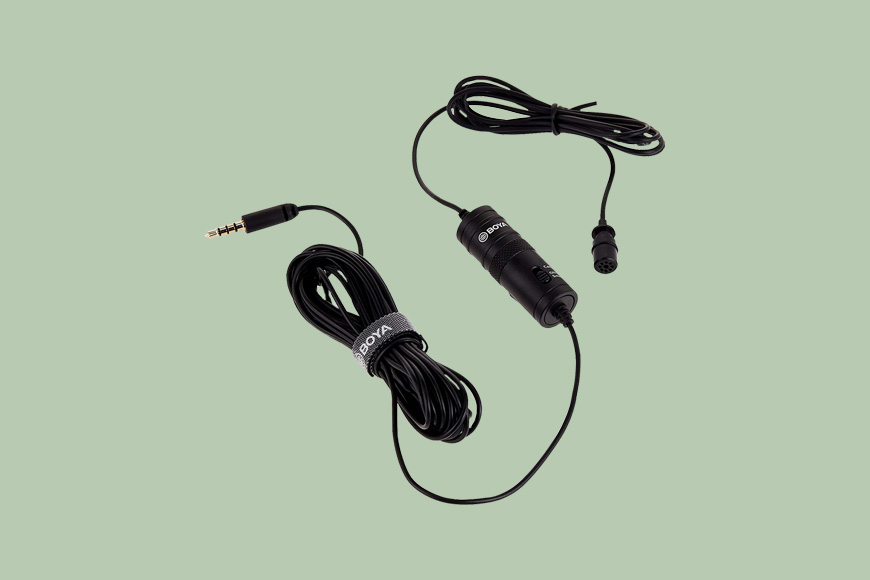
- Ultra-budget option for lavalier microphone
- Versatile compatibility with smartphones, DSLRs, camcorders, and more
- Compact and lightweight design
- Includes a long audio cable for convenience
- Basic functionality without advanced features
- Limited control options and adjustments
- May not offer the same level of sound quality as higher-end options
The BOYA by M1 wins the spot for the Best Ultra-Budget Lavalier Mic.
Don’t let its price fool you; it’s a clip-on mic that performs excellently with DSLRs, Camcorders, Audio recorders, PCs, and even Smartphones.
Although it needs a separate app for adjustments on iPhones, it’s a small hurdle considering the savings.
The BOYA by M1 is an omnidirectional condenser microphone, meaning it picks up sound equally from all directions.
Its surprisingly high-quality condenser makes it an ideal choice for video use, and it handles noise remarkably well.
You’ll appreciate its Vidpro XM-L Wired Lavalier microphone that comes with a 20′ Audio Cable, making it a breeze to set up for your recording needs.
If you’re on a tight budget, but you’re unwilling to compromise on quality, the BOYA by M1 is a reliable option to consider.
Just keep in mind the minor adjustment required for iPhone users.
What are Lavalier Mics Good For?
Lavalier mics, also known as lapel mics, are the Swiss Army knives of the audio recording world.
They’re small, unobtrusive, and capable of delivering professional-quality sound in a wide range of scenarios.
Here’s a quick rundown of what they’re good for:
- Video Production: They’re widely used in television, film, and news broadcasting due to their ability to be hidden discreetly on a subject’s clothing. They deliver clear, focused sound without capturing excessive background noise.
- Interviews: Whether you’re conducting a one-on-one interview or hosting a panel discussion, lavalier mics are ideal. They allow for natural movement and eye contact, making conversations feel more organic and less staged.
- Presentations & Public Speaking: Giving a lecture, presentation, or any form of public speaking can be nerve-racking. A lavalier mic attached to your clothing lets you focus on your delivery, rather than holding a microphone.
- Theatre Productions: Lavalier mics can be hidden in costumes, allowing actors to move freely while maintaining consistent audio quality.
- YouTube and Podcasting: Lavalier mics are popular with content creators. They offer high-quality audio, are easy to use, and allow for hands-free operation.
- Vlogging & Social Media Content: For influencers or anyone regularly creating video content for social media, lavalier mics provide a hassle-free solution for clear audio.
- Online Meetings & Remote Learning: As work and education increasingly move online, having a lavalier mic can dramatically improve audio clarity, making communication more effective.
Lavalier mics are about convenience and audio quality.
They’re designed to be discreet and unnoticeable while delivering high-quality sound, making them a versatile tool for anyone needing to capture or broadcast audio.
What are the downsides of using a lavalier mic?
While lavalier mics are versatile, they do have some drawbacks.
Due to their small size, they can’t capture the same full-bodied sound as larger microphones, making them less suitable for professional music recording.
They’re also prone to picking up noise from clothing rustle, wind, or even the speaker’s breath.
Plus, they can be a little tricky to position correctly for optimal sound. I usually use some gaffer tape.
In what situations would you NOT want to use lavalier mics?
Although great in many situations, lavalier mics might not be the best pick in high wind or noisy environments as they can pick up unwanted sounds.
They’re also less ideal for multi-person conversations unless everyone is mic’d up separately.
For musical performances, especially those involving instruments, lavalier mics usually don’t provide the depth and range of sound needed.
Lastly, they can be a bit invasive for some speakers who prefer not to be physically attached to a mic.
How Do I Choose a Lavalier Mic?
Here are some points to help you choose the right lavalier microphones:
- Sound Quality: This is the primary consideration when buying any microphone. Check the frequency response of the mic – a range of 20Hz to 20kHz is standard. It should also have a good signal-to-noise ratio.
- Polar Pattern: Lavalier mics typically come with omnidirectional or cardioid pickup patterns. Omnidirectional mics pick up sound equally from all directions, while cardioid mics focus on the sound source in front of them and reduce background noise.
- Wired vs Wireless: Wired lavalier mics are generally more affordable and don’t need batteries or charging. Wireless mics offer more mobility but can be more expensive and require power sources for the transmitter and receiver.
- Battery Life (for wireless): If you opt for a wireless lavalier mic, consider the battery life of the transmitter and receiver. They should last long enough to cover your longest recording sessions.
- Compatibility: Check if the mic is compatible with your recording device. Some mics work better with specific cameras, recorders, or smartphones.
- Durability: A durable, well-constructed mic will withstand regular use better. Consider the build quality and the materials used in the mic and its cable.
- Size and Discreetness: A smaller, more discreet lavalier mic is less likely to distract viewers in video productions.
- Ease of Use: Some lavalier mics are plug-and-play, while others require a more complex setup. Consider your technical expertise and the time you’re willing to spend on setup and adjustments.
- Mounting Clips and Accessories: Check what comes with the mic. Useful accessories can include multiple mounting clips, windscreens for outdoor use, and carry cases.
- Brand Reputation and Reviews: Lastly, consider the reputation of the brand and read customer reviews. This can provide insight into the mic’s performance over time and any potential issues.
5 Tips for Using Lavalier Mics to Record High-Quality Audio
Here are some useful tips to ensure you get high-quality audio with lavalier microphones:
- Placement is crucial. Aim to clip the mic about 6-8 inches below the speaker’s mouth, usually on the chest area. It’s close enough to capture the voice clearly, but far enough to avoid harsh plosive sounds. Also, make sure it’s centered to avoid favoring one side.
- Avoid rustling. Be mindful of the clothing the speaker is wearing. Fabrics that rustle can interfere with your sound. Test it out before you start recording to make sure clothing noise isn’t an issue.
- Wind protection. If you’re recording outside, wind noise can be a problem. Consider using a foam windscreen or even a professional-grade furry windjammer to reduce this.
- Be conscious of movement. If the speaker will be moving a lot, secure the cable with tape to prevent noise from movement.
Above all, always test your audio levels before you start recording to ensure you’re getting a clean, clear sound.
Lavalier Microphone FAQs
How do lavalier mics work?
Lavalier mics, or lapel mics, work by capturing sound waves from your voice and converting them into an electrical signal. This tiny but powerful mic is usually clipped to your clothing close to the mouth to ensure the best sound capture.
What are the different types of lavalier mics?
There are wired and wireless lavalier mics. Wired ones directly connect to your recording device, offering a reliable signal. Wireless ones offer more freedom of movement and are great for performances or presentations. Lavs can also vary in terms of polar pattern, with omnidirectional mics picking up sound from all directions, and directional mics focusing on sound from a specific direction.
What are the advantages of using a lavalier mic?
Lavalier mics offer hands-free operation, great for presentations, interviews, or performances. They’re discreet, provide consistent audio capture, and allow for natural movement without the worry of mic positioning.
What are the disadvantages of using a lavalier mic?
While lavaliers are great, they can pick up unwanted noise, like clothing rustle. Also, their small size can sometimes lead to less rich sound capture compared to larger mics. Lastly, they can sometimes be visible, which might not be ideal for certain video productions.





